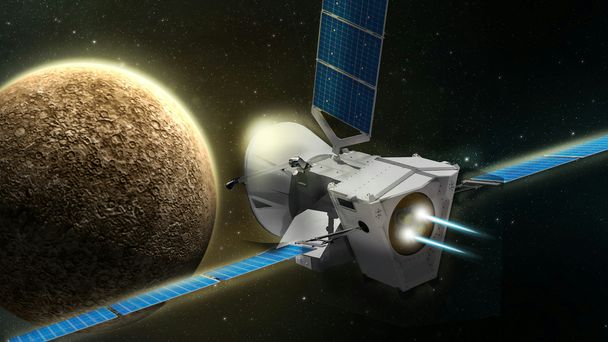Ariane 5 successfully launched from Kourou: BepiColombo is now on its long ‘braking path’ to Mercury

Two missions in one will travel 8.5 billion kilometres through the inner solar system
Industrial consortium of 83 companies from 16 countries led by Airbus
@BepiColombo @ESA_Bepi @esascience @ESA_MTM @JAXA_MMO #Mercury #VA245 #Kourou @AirbusSpace
Kourou, 20 October 2018 – The European-Japanese BepiColombo mission to Mercury was successfully launched this morning, Saturday 20 October, at 03:45 am (CET) from the spaceport in Kourou (French Guiana) on an Ariane 5 launcher. The satellite built by Airbus for the European Space Agency (ESA) and Japanese Space Agency (JAXA) is now embarking on its long journey of some 8.5 billion kilometres through the inner solar system, reaching our solar system’s innermost planet in seven years.
After arrival in 2025, for the first time two space probes will simultaneously observe Mercury and its environment. Plans include using cameras to map the planet’s surface more precisely than ever before. Data collected from 16 scientific instruments will provide insights into the geological and chemical composition of the planet, along with its structure, the characteristics of its magnetic field and how it interacts with the solar wind.
“This very complex mission is the result of a truly inspiring international cooperation among 83 companies from 16 European countries and Japan”, said Nicolas Chamussy, Head of Space Systems. “This international effort, with Airbus teams from five countries, is the natural consequence of humanity's desire to discover more about this little known planet and the origins of our solar system. All great missions come with challenges: Airbus had to develop sophisticated thermal control solutions and even “special” solar arrays, capable of tilting 75 degrees away from the Sun to limit the temperature. Now its challenge is to complete the journey safely and deliver the science we're all waiting for."
The Ariane 5 launched ‘Bepi’ into space at ‘escape velocity’ – the speed required for an object to break free of the Earth’s gravitational pull. This will allow the space probe to enter a solar orbit similar to that of the Earth at speeds of around 120,000 km/h. During its journey to Mercury, BepiColombo will make several braking manoeuvres to adjust its orbit, allowing it to make a slow approach towards the planet.
In order to achieve this, the control centre – the European Space Operations Centre (ESOC) in Darmstadt, Germany – has plotted a sophisticated course through the inner solar system. It will apply the brakes just 60 days into the journey to reduce Bepi’s speed: an electric propulsion system and a total of nine planetary swing-bys (one of the Earth in April 2020, two of Venus and six of Mercury) will provide BepiColombo with the energy it requires. A maximum of two of the four xenon-propelled ion thrusters will be employed at any one time during the long journey; these will be used on more than 700 days in total, up to four months of which without interruption. The thrusters will be powered by two 1.8 x 14-metre solar arrays. The ion thrusters, a further chemical propulsion system and the solar arrays are located on the Mercury Transfer Module (MTM), the propulsion module for the interplanetary voyage to Mercury.
With the journey totalling some 8.5 billion kilometres – the equivalent of travelling from the Earth to Neptune and back again – Bepi will actually travel 38 times the maximum distance between the Earth and Mercury. After travelling for seven years and completing 18 orbits around the Sun, the MTM will be jettisoned in 2025. From that point onwards, the orbiters will power themselves using solar energy and their own propulsion system. The space probe will then swing into orbit around Mercury before each orbiter enters its own orbit and begins the actual scientific exploration of the planet.
About BepiColombo
BepiColombo is a joint project of the European Space Agency (ESA) and Japanese Space Agency (JAXA). As the prime industrial contractor, Airbus leads a consortium of 83 companies from 16 countries. ESA, JAXA and Airbus worked together to set the scientific objectives of the mission, a basis that was then used to develop the BepiColombo research satellite. The impressive space probe consists of four elements: ESA’s Mercury Planetary Orbiter (MPO) and JAXA’s Mercury Magnetospheric Orbiter (MMO), the Sunshield and Interface Structure (MOSIF) for the MMO and the Mercury Transfer Module (MTM). BepiColombo is 6.4 metres high and weighs four tonnes. The mission is named after Italian mathematician and engineer Professor Giuseppe ‘Bepi’ Colombo (1920–1984), who was instrumental in the success of the Mariner 10 mission that flew by Mercury three times in 1974-75.
You can download photos, videos, footage, infographics and interviews at:
https://www.airbus.com/space/space-exploration/bepicolombo.html
***
About Airbus
Airbus is a global leader in aeronautics, space and related services. In 2017 it generated revenues of € 59 billion restated for IFRS 15 and employed a workforce of around 129,000. Airbus offers the most comprehensive range of passenger airliners from 100 to more than 600 seats. Airbus is also a European leader providing tanker, combat, transport and mission aircraft, as well as one of the world’s leading space companies. In helicopters, Airbus provides the most efficient civil and military rotorcraft solutions worldwide.
Your contact
Ralph Heinrich
AIRBUS | Defence and Space
Francisco Lechón
External Communications - Airbus Space Systems, Spain
Jeremy Close
AIRBUS | Defence and Space
Guilhem Boltz
AIRBUS | Defence and Space